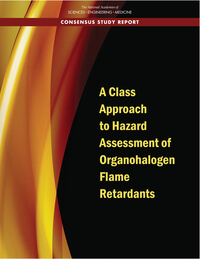CPSC Flame Retardant Petition
Beginning in 2011, our “big idea” project initiated a paradigm shift towards managing harmful chemicals by class rather than one at a time. In 2017, the Consumer Product Safety Commission (CPSC) accepted our joint petition to ban furniture, children’s products, electronics casings, and mattresses that contain any member of the chemical class of additive non-polymeric organohalogen flame retardants.

The problem: harmful flame retardants in household products
Among the tens of thousands of synthetic chemicals, the class of organohalogens (in which carbon is bonded to bromine, chlorine, or fluorine) is uniquely problematic. These chemicals are often toxic, persistent, and bioaccumulative in our bodies and the environment. Many are similar in structure or even identical to banned chemicals such as DDT, Mirex, and PCBs. All 29 chemicals globally banned as Persistent Organic Pollutants under the Stockholm Convention are organohalogens.
One major use of organohalogens is as flame retardants added to furniture, children’s products, electronics, and building insulation to meet flammability standards. They often don’t improve fire safety and can harm our health. You can watch a short video and learn more here.
Biomonitoring studies find organohalogen flame retardants in the bodies of nearly all Americans tested, with the highest levels in young children. These chemicals cause reproductive, immune, and neurological problems and cancer in animal studies. In humans exposure is associated with reduced IQ and fertility, birth defects, and hormonal changes. If we can reduce human exposure to this class of toxic chemicals, we can prevent health problems.
The good news is that the use of flame retardants can be greatly reduced without impacting fire safety. Safer substitute chemicals and technologies are available.
Our 2015 Science-Based Petition to the CPSC
Given the toxicity and persistence of organohalogen flame retardants, we collaborated with Earthjustice, beginning in 2011, to draft a petition to the CPSC to ban the use of products containing these chemicals. In 2015, a coalition of medical, firefighter, consumer, and scientific groups joined us and asked the CPSC to adopt rules under the Federal Hazardous Substances Act to protect consumers from organohalogen flame retardants in four categories of household products:
- residential furniture
- children’s products
- the outer casings of electronics
- any mattress or mattress pad
Read the full text of the petition and supporting statements.
This petition puts forth the class concept, a new approach for addressing harmful chemicals by class rather than one-by-one. This approach helps prevent regrettable substitutions, where phased out chemicals are replaced with chemical cousins with similarly harmful properties.
The decision
After years of coordinated effort by our Institute and partners, the CPSC granted our petition in September 2017. A precedent-setting notice was published in the Federal Register warning manufacturers, consumers, and especially pregnant women and children against using the entire class of organohalogen flame retardants in children's products, furniture, mattresses, and electronics cases.

The National Academy of Sciences report
To implement this decision, the National Academy of Sciences (NAS) assembled a guidance committee of experts. In May of 2019 this committee issued a report endorsing a class-based approach for regulating halogenated flame retardants. This report reaffirms the usefulness of the class concept and the problem of "regrettable substitution."
This report:
- notes that assessing chemicals as a class would make regulatory hazard and risk assessment much more efficient.
- states that the individual assessments of hundreds of chemicals is unrealistic. “The only possible practical approach for a set of chemicals as large as the OFRs is a class approach."
- defines 14 subclasses based on chemistry (6 subclasses) and predicted health impact (8 subclasses).
Next steps for the petition
Potential next steps include:
- If the CPSC agrees to follow the NAS recommendations, they will do in-depth literature studies of the subclass members.
- The CPSC forms a Chronic Hazard Advisory Panel and charges them with carrying out the class-based hazard assessment.
Scientists’ Support for the Petition
Organohalogen flame retardants have highly persistent and toxic combustion by-products, readily bioaccumulate and can act as endocrine disruptors.
— Terrence Collins, PhD — Download his full statement.
Teresa Heinz Professor of Green Chemistry and Director, Institute for Green Science, Carnegie Mellon University
All organohalogen flame retardants – because they are semi-volatile organic compounds – will tend to migrate out of the consumer products resulting in human exposure.
— Miriam Diamond, PhD — Download her full statement.
Professor of Geography, Chemical Engineering and Applied Chemistry, University of Toronto
All of the non-polymeric OFRs [organohalogen flame retardants] that we have screened were found to be either of high concern or toxic.
— David Eastmond, PhD — Download his full statement with supporting materials.
Professor and Chair, Dept. of Cell Biology and Neuroscience, and Research Toxicologist, University of California, Riverside
This class of chemicals easily enters the cells, may decrease the cells’ ability to keep out other toxic compounds, and can cause adverse health effects.
— David Epel, PhD — Download his full statement.
Professor Emeritus in Marine Sciences, Cell and Developmental Biology, Hopkins Marine Station, Stanford
The mass manufacture of toxic chemicals that lack effective routes of degradation creates problems for current and future generations.
— Rolf Halden, PhD — Download his full statement.
Director, Center for Environmental Security and Professor of Engineering, Arizona State University; Adjunct Faculty, Johns Hopkins Bloomberg School of Public Health
Women with higher levels of flame retardants in their blood: (i) took significantly longer to get pregnant; (ii) had babies with lower birth weight; and (iii) had lower thyroid hormone levels during pregnancy.
By the time children were 5 to 7 years old, their mother’s flame retardant exposure during pregnancy was associated with lower IQ (a decrease by 6 points on average), attention problems, and impaired fine motor coordination, …
— Kim Harley, PhD — Download her full statement.
Associate Adjunct Professor in Maternal and Child Health and Associate Director for Health Effects, Center for Environmental Research and Children’s Health, University of California, Berkeley
My professional opinion is that there is reason to be concerned that the entire class of organohalogen flame retardants may cause injury or illness to humans, particularly to fetuses and young children.
— Julie Herbstman, PhD — Download her full statement.
Assistant Professor of Environmental Health Sciences, Columbia University Mailman School of Public Health
The available data on organohalogen flame retardants indicates a high likelihood that other yet unstudied members of this class of chemicals are also endocrine disruptors, which means they can impair normal cell development, and thus cause substantial personal injury or substantial illness.
— Susan Kasper, PhD — Download her full statement.
Associate Professor of Environmental Health, University of Cincinnati, College of Medicine
Organohalogen flame retardants in products during fires can increase the amounts of persistent organic pollutants produced by combustion processes, thus increasing the chronic toxicity of fires.
— Donald Lucas, PhD — Download his full statement.
Retired Scientist, Lawrence Berkeley National Lab; Professional Researcher, School of Public Health, University of California, Berkeley
Given that organohalogen flame retardants in furniture, mattresses, children’s products and electronics casings as currently used do not stop fires, but increase the risk of cancer for firefighters, I see no justification for their use.
— Sharyle Patton — Download her full statement.
Director, Commonweal Environmental Health Program
Our 2011 study indicated that banning individual flame retardants is ineffective because manufacturers tend to replace them with other chemicals with similar structures and hazards, including chemicals with uncharacterized toxicity.
— Ruthann Rudel, MS — Download her full statement with supporting materials.
Director of Research, Silent Spring Institute
Virtually all halogenated flame retardants have adverse impacts when they interact with cells and tissues of living organisms.
— Ted Schettler, MD, MPH — Download his full statement.
Physician and Science Director, Science and Environmental Health Network; Science Director, Collaborative on Health and Environment
Dioxins and furans have been found as impurities in organohalogen flame retardants in consumer products. They are likely human carcinogens and have been linked – at very low doses – to a wide range of other adverse health effects.
— Roland Weber, PhD — Download his full statement.
Independent Consultant for Persistent Organic Pollutants, POPs Environmental Consulting, Germany
The petitioners
- American Academy of Pediatrics (AAP)
- American Medical Women’s Association (AMWA)
- Consumer Federation of America (CFA)
- Consumers Union
- Green Science Policy Institute
- International Association of Fire Fighters (IAFF)
- Kids in Danger
- League of United Latin American Citizens (LULAC)
- Learning Disabilities Association of America (LDA)
- National Hispanic Medical Association (NHMA)
- Philip Landrigan, M.D.
- Worksafe
Legal Counsel: Earthjustice and Consumer Federation of America (CFA)
In the Media
- Hawthorne M. Federal panel votes to warn public about flame retardants in baby products, furniture. Chicago Tribune. September 20, 2017.
- Firefighters, consumer advocates push to ban flame-retardant products. FireChief. April 1, 2015.
- Blum A. & Gartner E. Government asked to ban household products with harmful class of chemicals. The Hill, Congress Blog. March 31, 2015.